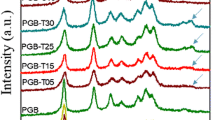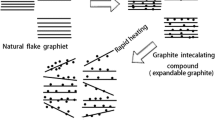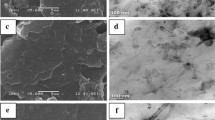Abstract
Conductive biodegradable polymer composites have broad application prospects, but obtaining composites with high electrical conductivity and good mechanical properties at low filler content has been an important challenge. In this work, we melt blended poly(lactic acid) (PLA) and one-dimensional (1D) carbon nanotubes (CNTs) and found that CNTs can form part of the conductive network in the polymer matrix to improve its electrical conductivity. However, to achieve high electrical conductivity, PLA should be mixed with large amounts of CNTs, which inevitably impairs its mechanical properties. When carbon black (CB) was mechanically mixed with PLA/CNTs particles with sizes less than 200 μm, it not only formed a conductive network structure by itself but also interconnected with the CNTs network within the PLA/CNTs composites. Ultimately, a segregated double filler (0D CB–1D CNTs) network structure was constructed in PLA nanocomposites. The resulting nanocomposites achieved good electrical conductivity, tensile strength, flexural strength, and impact toughness of 9.8 × 10−2 S/m, 70.1 MPa, 91.3 MPa, and 2.8 kJ/m2 at the addition of 1 phr CNTs and 1 phr CB, respectively. These results demonstrate that PLA-based composites with high electrical conductivity and good mechanical properties could be prepared using this technique at low filler content. This extends the application scope of PLA composites.
Graphical Abstract











Similar content being viewed by others
References
Tansel B (2017) From electronic consumer products to e-wastes: Global outlook, waste quantities, recycling challenges. Environ Int 98:35–45
Kuang T, Ju J, Liu T, Hejna A, Saeb MR, Zhang S, Peng X (2022) A facile structural manipulation strategy to prepare ultra-strong, super-tough, and thermally stable polylactide/nucleating agent composites. Adv Compos Hybrid Mater 5(2):948–959
Kuang T, Ju J, Chen F, Liu X, Zhang S, Liu T, Peng X (2022) Coupled effect of self-assembled nucleating agent, Ni-CNTs and pressure-driven flow on the electrical, electromagnetic interference shielding and thermal conductive properties of poly (lactic acid) composite foams. Compos Sci Technol 230:109736
Chen Y, Lin J, Mersal GAM, Zuo JL, Li JL, Wang QY, Feng YH, Liu JW, Liu ZL, Wang B, Xu BB, Guo ZH (2022) “Several birds with one stone” strategy of pH/thermoresponsive flame-retardant/photothermal bactericidal oil-absorbing material for recovering complex spilled oil. J Mater Sci Technol 128:82–97
Pan D, Yang G, Abo-Dief HM, Dong JW, Su FM, Liu CT, Li YF, Xu BB, Murugadoss V, Naik N, El-Bahy SM, El-Bahy ZM, Huang MA, Guo ZH (2022) Vertically aligned silicon carbide nanowires/boron nitride cellulose aerogel networks enhanced thermal conductivity and electromagnetic absorbing of epoxy composites. Nano-Micro Lett 14(1):118
Ju J, Peng X, Huang K, Li L, Liu X, Chitrakar C, Chang L, Gu Z, Kuang T (2019) High-performance porous PLLA-based scaffolds for bone tissue engineering: Preparation, characterization, and in vitro and in vivo evaluation. Polymer 180:121707
Liu T, Lian X, Li L, Peng X, Kuang T (2020) Facile fabrication of fully biodegradable and biorenewable poly (lactic acid)/poly (butylene adipate-co-terephthalate) in-situ nanofibrillar composites with high strength, good toughness and excellent heat resistance. Polym Degrad Stab 171:109044
Kuang TR, Zhang JB, Chen F, Fei YP, Zhou HF, Weng YX, Liu T, Yang JT, Zhong MQ (2022) A simple, low-cost, and green method for preparing strong, tough, and ductile poly(lactic acid) materials with good transparency and heat resistance. Acs Sustain Chem Eng 10:16389–16398
Wang Z, Liu T, Yang JT, Chen F, Fei YP, Zhong MQ, Kuang TR (2022) Biomimetically structured poly(lactic acid)/poly(butylene-adipate-co-terephthalate) blends with ultrahigh strength and toughness for structural application. Acs Appl Polym Mater 4:9351–9359
Wen X, Liu Z, Li Z, Zhang J, Wang D-Y, Szymańska K, Chen X, Mijowska E, Tang T (2020) Constructing multifunctional nanofiller with reactive interface in PLA/CB-g-DOPO composites for simultaneously improving flame retardancy, electrical conductivity and mechanical properties. Compos Sci Technol 188:107988
Wu D, Lv Q, Feng S, Chen J, Chen Y, Qiu Y, Yao X (2015) Polylactide composite foams containing carbon nanotubes and carbon black: Synergistic effect of filler on electrical conductivity. Carbon 95:380–387
Kuan C-F, Kuan H-C, Ma C-CM, Chen C-H (2008) Mechanical and electrical properties of multi-wall carbon nanotube/poly(lactic acid) composites. J Phys Chem Solids 69(5):1395–1398
Cui C-H, Yan D-X, Pang H, Xu X, Jia L-C, Li Z-M (2016) Formation of a segregated electrically conductive network structure in a low-melt-viscosity polymer for highly efficient electromagnetic interference shielding. ACS Sustain Chem Eng 4(8):4137–4145
Wang Y, Yang C, Xin Z, Luo Y, Wang B, Feng X, Mao Z, Sui X (2022) Poly (lactic acid)/carbon nanotube composites with enhanced electrical conductivity via a two-step dispersion strategy. Compos Commun 30:101087
Yu B, Zhao Z, Fu S, Meng L, Liu Y, Chen F, Wang K, Fu Q (2019) Fabrication of /CNC/CNT conductive composites for high electromagnetic interference shielding based on Pickering emulsions method. Compos Part A-Appl Sci 125:105558
Wang Z, Zhu HB, Cao N, Du RK, Liu YQ, Zhao GZ (2017) Superhydrophobic surfaces with excellent abrasion resistance based on benzoxazine/mesoporous SiO2. Mater Lett 186:274–278
Li XY, Zhao SP, Hu WH, Zhang X, Pei L, Wang Z (2019) Robust superhydrophobic surface with excellent adhesive properties based on benzoxazine/epoxy/mesoporous SiO2. Appl Surf Sci 481:374–378
Hu WH, Huang JG, Zhang X, Zhao SP, Pei L, Zhang CY, Liu YQ, Wang Z (2020) A mechanically robust and reversibly wettable benzoxazine/epoxy/mesoporous TiO2 coating for oil/water separation. Appl Surf Sci 507:145168
Deng H, Lin L, Ji M, Zhang S, Yang M, Fu Q (2014) Progress on the morphological control of conductive network in conductive polymer composites and the use as electroactive multifunctional materials. Prog Polym Sci 39(4):627–655
Wang M, Tang X-H, Cai J-H, Wu H, Shen J-B, Guo S-Y (2021) Construction, mechanism and prospective of conductive polymer composites with multiple interfaces for electromagnetic interference shielding: A review. Carbon 177:377–402
Yao FC, Xie WH, Ma C, Wang DD, El-Bahy ZM, Helal MH, Liu H, Du A, Guo ZH, Gu HB (2022) Superb electromagnetic shielding polymer nanocomposites filled with 3-dimensional p-phenylenediamine/aniline copolymer nanofibers@copper foam hybrid nanofillers. Compos Part B-Eng 245:110236
Ren F, Li Z, Xu L, Sun Z, Ren P, Yan D, Li Z (2018) Large-scale preparation of segregated PLA/carbon nanotube composite with high efficient electromagnetic interference shielding and favourable mechanical properties. Compos Part B-Eng 155:405–413
Guo J, Tsou C-H, Yu Y, Wu C-S, Zhang X, Chen Z, Yang T, Ge F, Liu P, Guzman MRD (2021) Conductivity and mechanical properties of carbon black-reinforced poly(lactic acid) (PLA/CB) composites. Iran Polym J 30(12):1251–1262
Kashi S, Gupta RK, Baum T, Kao N, Bhattacharya SN (2016) Morphology, electromagnetic properties and electromagnetic interference shielding performance of poly lactide/graphene nanoplatelet nanocomposites. Mater Des 95:119–126
Wang Y, Wang P, Du Z, Liu C, Shen C, Wang Y (2022) Electromagnetic interference shielding enhancement of poly (lactic acid)-based carbonaceous nanocomposites by poly (ethylene oxide)-assisted segregated structure: a comparative study of carbon nanotubes and graphene nanoplatelets. Adv Compos Hybrid Mater 5(1):209–219
Urquijo J, Aranburu N, Dagréou S, Guerrica-Echevarría G, Eguiazábal J (2017) CNT-induced morphology and its effect on properties in PLA/PBAT-based nanocomposites. Eur Polym J 93:545–555
Zhu QS, Zhao Y, Miao BJ, Abo-Dief HM, Qu MC, Pashameah RA, Bin XuB, Huang MA, Algadi H, Liu XH, Guo ZH (2022) Hydrothermally synthesized ZnO-RGO-PPy for water-borne epoxy nanocomposite coating with anticorrosive reinforcement. Prog Org Coat 172:107153
Luo Y, Xiong SY, Zhang F, He XX, Lu X, Peng RT (2021) Preparation of conductive polylactic acid/high density polyethylene/carbon black composites with low percolation threshold by locating the carbon black at the Interface of co-continuous blends. J Appl Polym Sci 138(17):50291
Potschke P, Bhattacharyya AR, Janke A (2004) Carbon nanotube-filled polycarbonate composites produced by melt mixing and their use in blends with polyethylene. Carbon 42(5–6):965–969
Kuang T, Chang L, Chen F, Sheng Y, Fu D, Peng X (2016) Facile preparation of lightweight high-strength biodegradable polymer/multi-walled carbon nanotubes nanocomposite foams for electromagnetic interference shielding. Carbon 105:305–313
Ju J, Kuang T, Ke X, Zeng M, Chen Z, Zhang S, Peng X (2020) Lightweight multifunctional polypropylene/carbon nanotubes/carbon black nanocomposite foams with segregated structure, ultralow percolation threshold and enhanced electromagnetic interference shielding performance. Compos Sci Technol 193:108116
Lu Y, Sun DX, Qi XD, Lei YZ, Yang JH, Wang Y (2020) Achieving ultrahigh synergistic effect in enhancing conductive properties of polymer composites through constructing the hybrid network of “rigid” submicron vapor grown carbon fibers and “reelable” carbon nanotubes. Compos Sci Technol 193:108141
Bai QQ, Jin XZ, Yang JH, Qi XD, Wang Y (2019) Constructing network structure of graphene nanoplatelets/carbon nanofibers in polystyrene and the resultant heat resistance, thermal and conductive properties. Compos Part A-Appl Sci Manuf 117:299–307
Shi SH, Peng ZL, Jing JJ, Yang L, Chen YH, Kotsilkova R, Ivanov E (2020) Reparation of highly efficient electromagnetic interference shielding polylactic acid/graphene nanocomposites for fused deposition modeling three-dimensional printing. Ind Eng Chem Res 59(35):15565–15575
Wang LJ, Qiu JH, Sakai E, Wei XW (2016) The relationship between microstructure and mechanical properties of carbon nanotubes/polylactic acid nanocomposites prepared by twin-screw extrusion. Compos Part A-Appl Sci Manuf 89:18–25
Li Y, Yin DX, Liu W, Zhou HF, Zhang YX, Wang XD (2020) Fabrication of biodegradable poly (lactic acid)/carbon nanotube nanocomposite foams: significant improvement on rheological property and foamability. Int J Biol Macromol 163:1175–1186
Murariu M, Bonnaud L, Yoann P, Fontaine G, Bourbigot S, Dubois P (2010) New trends in polylactide (PLA)-based materials: “Green” PLA-Calcium sulfate (nano) composites tailored with flame retardant properties. Polym Degrad Stabil 95(3):374–381
Lei YZ, Bai Y, Shi Y, Liang M, Zou HW, Zhou ST (2022) Composite nanoarchitectonics of poly(vinylidene fluoride)/graphene for thermal and electrical conductivity enhancement via constructing segregated network structure. J Polym Res 29(5):213
Gao CW, Feng CP, Lu H, Ni HY, Chen J (2018) Thermally conductive general-purpose polystyrene (GPPS)/graphite composite with a segregated structure: effect of size of resin and graphite flakes. Polym-Plast Technol 57(13):1277–1287
Ecker JV, Haider A, Burzic I, Huber A, Eder G, Hild S (2019) Mechanical properties and water absorption behaviour of PLA and PLA/wood composites prepared by 3D printing and injection moulding. Rapid Prototyp J 25(4):672-678
Jayanth N, Jaswanthraj K, Sandeep S, Mallaya NH, Siddharth SR (2021) Effect of heat treatment on mechanical properties of 3D printed PLA. J Mech Behav Biomed 123:104764
Quan H, Zhang SJ, Qiao JL, Zhang LY (2012) The electrical properties and crystallization of stereocomplex poly(lactic acid) filled with carbon nanotubes. Polymer 53(20):4547–4552
Kobashi K, Villmow T, Andres T, Potschke P (2008) Liquid sensing of melt-processed poly(lactic acid)/multi-walled carbon nanotube composite films. Sensor Actuat B-Chem 134(2):787–795
Kim HS, Chae YS, Park BH, Yoon JS, Kang M, Jin HJ (2008) Thermal and electrical conductivity of poly(L-lactide)/multiwalled carbon nanotube nanocomposites. Curr Appl Phys 8(6):803–806
Zhang K, Peng JK, Shi YD, Chen YF, Zeng JB, Wang M (2016) Control of the crystalline morphology of poly(L-lactide) by addition of high-melting-point poly(L-lactide) and its effect on the distribution of multiwalled carbon nanotubes. J Phys Chem B 120(30):7423–7437
Zhang DG, Liu X, Wu GZ (2016) Forming CNT-guided stereocomplex networks in polylactide-based nanocomposites. Compos Sci Technol 128:8–16
Zhang ZX, Xiang D, Wu YP, Zhang J, Li YX, Wang MH, Li ZY, Zhao CX, Li H, Wang P, Li YT (2022) Effect of carbon black on the strain sensing property of 3D printed conductive polymer composites. Appl Compos Mater 29(3):1235–1248
Bertolini MC, Ramoa SDAS, Merlini C, Barra GMO, Soares BG, Pegoretti A (2020) Hybrid composites based on thermoplastic polyurethane with a mixture of carbon nanotubes and carbon black modified with polypyrrole for electromagnetic shielding. Front Mater 7:174.
Zhou ST, Hrymak AN, Kamal MR (2018) Effect of hybrid carbon fillers on the electrical and morphological properties of polystyrene nanocomposites in microinjection molding. Nanomaterials 8(10):779
Schmitz DP, Ecco LG, Dul S, Pereira ECL, Soares BG, Barra GMO, Pegoretti A (2018) Electromagnetic interference shielding effectiveness of ABS carbon-based composites manufactured via fused deposition modelling. Mater Today Commun 15:70–80
Funding
This work was financially supported by the National Natural Science Foundation of China (Nos. 51873193, 51803062, 52173046, and 52173086) and Natural Science Foundation of Zhejiang Province (No. LZ21E030002).
Author information
Authors and Affiliations
Contributions
T. R. Kuang, M. L. Zhang, B. Z. Wu, and T. Liu wrote the main manuscript text; F. Chen, Y. P. Fei, J. T. Yang, M. Q. Zhong, and B. Z. Wu provided pieces of advice and suggestions; T. R. Kuang, M. L. Zhang, and T. Liu prepared Figs. 1, 2, 3, 4, 5, 6, 7, 8, 9, and 10. All the authors reviewed the manuscript.
Corresponding authors
Ethics declarations
Conflict of interest
The authors declare no competing interests.
Additional information
Publisher's Note
Springer Nature remains neutral with regard to jurisdictional claims in published maps and institutional affiliations.
Supplementary Information
Below is the link to the electronic supplementary material.
Rights and permissions
Springer Nature or its licensor (e.g. a society or other partner) holds exclusive rights to this article under a publishing agreement with the author(s) or other rightsholder(s); author self-archiving of the accepted manuscript version of this article is solely governed by the terms of such publishing agreement and applicable law.
About this article
Cite this article
Kuang, T., Zhang, M., Chen, F. et al. Creating poly(lactic acid)/carbon nanotubes/carbon black nanocomposites with high electrical conductivity and good mechanical properties by constructing a segregated double network with a low content of hybrid nanofiller. Adv Compos Hybrid Mater 6, 48 (2023). https://doi.org/10.1007/s42114-022-00622-z
Received:
Revised:
Accepted:
Published:
DOI: https://doi.org/10.1007/s42114-022-00622-z




